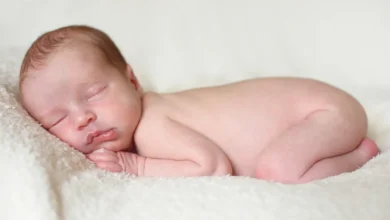How Dads Can Change a Baby Girl’s Nappy
A Dad’s Guide to Changing a Baby Girl’s Nappy with Ease
Nappy Changing Time
Be sure you have all the necessary items at hand before you start changing the nappy of your daughter. This means baby-friendly wipes and new clothes if necessary, as well as a place to store the used wipes like a nappy bag or nappy pouch. If you don’t own a changing table, use a towel on the floor or a changing pad. Keep your eyes and hands on your baby at all times. Focus is important because babies can move quickly and fall. Unseal the tabs on the front of the nappy to remove them if you find that the nappy is wet or poopy. Let’s clean the parts we need to. Gently flex your baby’s legs towards their stomach by holding their feet together. Remove the nappy from your baby’s reach. Once the baby has been changed, you can clean up.

Pro tip: Stinky situation? If you’re a little squeamish about smells or are sensitive to them, try mouth breathing.
Take a few wipes and clean up your baby. Do a quick once-over, concentrating first on the bottom and back. After that, place your baby on a clean towel or change mat.
Start a detailed cleaning of the genital region and surrounding areas.
How to Clean and Wipe Your Baby’s Genitals
You must wipe baby girls from the front to the back so as not to transfer bacteria from their bottoms into their sensitive genital areas (where they could enter their vagina or urethra, causing an infection).
Baby girls must also be wiped quickly and gently from the inside out of the genital region. It is important to do this if poop is on the genitals. Keep bacteria away from the vulva and vagina (the exterior genitals). You don’t need to dig in there. All that’s needed is a quick and careful cleanup of what you can see and the removal of any traces of poop or pee.
Tip: Instead of using baby wipes, use cotton balls that have been dipped into warm water if your baby’s skin is very sensitive.
If you want to avoid nappy-rash, use a soft tissue or face wash and gently wipe the area. You can also let your child air dry and distract them by playing fun games. Make sure that the tops and folds on the thighs are wiped, since they can cause painful sores. Apply a nappy or baby barrier cream on dry, clean skin. Put on a new nappy and dress your child. It may seem complicated at first but it becomes second nature after
Vaginal Discharge is Normal in Newborn Girls.
Do not worry if you see a discharge that looks white on the genitals of your baby girl. You don’t have to remove this discharge.
Do not worry if your daughter’s discharge is blood-tinged in the first couple of weeks following birth. It is normal, and the cause is due to maternal hormones that are still present in your baby. This will disappear on its own.
You can seek advice from your G or a maternal-child health nurse if you have concerns about a discharge.
When to Change Your Baby
The Royal Children’s Hospital says that each baby is unique and will often wet or poop their diaper during or after a feeding.
To avoid having to change the nappy two times, you should change your baby’s nappy immediately after feeding if your baby tends to have a wet nappy or poopy one after feeding.
Your baby may vomit when they are too moved with an empty stomach. You might want to change your child before feeding.
Parents who are experienced will often use the “sniff test”, feel the nappies from the outside, or look for indicators on the nappies that indicate when it’s time to change their baby.

How do I Take Care of My Baby’s Genitals and Scrotum?
Your baby girl is a cutie. Genitals: It is important to be gentle when cleaning this area. It is important to clean your baby’s genitals. This will reduce the chance of infection and keep your baby healthy. Learn everything you need about newborn genital hygiene, from changing nappies to bathing.
How Do I Clean the Genitals of My Baby Girl?
Warm water is all you need to clean the genitals of your baby girl. Water Fresh cotton wool. During the first couple of weeks, it’s best not to use any skincare products. Their skin will mature naturally.
Your newborn should be at least two years old and four weeks old. You can use baby wipes to clean their genitals. Be sure to use mild wipes that are free of alcohol and perfume. You can also add some liquid baby cleanser after a couple of weeks to the water. Mild baby cleansers will protect your baby’s skin barrier. Remember to clean your baby’s genitals thoroughly.
After the first two weeks, You can add some liquid baby cleanser to your water. Mild baby cleansers will protect your baby’s skin barrier. Remember to clean your baby’s genitals thoroughly.
Your baby may be suffering from a gastrointestinal disorder prematurely. It’s best not to use any skincare products for at least six to eight weeks, as the protective barrier of your skin takes longer to develop.
You should also check if your baby wipes or liquid cleanser is suitable for sensitive skin. Test them first on a small patch of skin. You should dilute your cleanser with water before using it on your baby.
How Can I Remove Poop From the Genital Area of My Baby Girl?
You can also find out more about us on our website. Nappy Changes You can wipe the majority of the poo off their bottom with a piece of clean nappy. You can use cotton wool with warm water to clean the baby and remove any remaining poo. After a few weeks, you can use baby wipes.
Always wipe your baby from front to rear to avoid bacteria getting into the vagina (the tube which carries urine from the bladder to the outside of the body) and the urethra. It is important to wipe from front to rear to reduce the chance of your baby becoming ill. Urinary tract infection (UTI. If your baby has a very explosive poo or an extremely Dirty nappy, Where? Poo If you find that your vaginal lip (labia) is swollen, you can take the following steps:
- Separate the lips of your baby’s uterus gently with clean fingertips.
- Wipe from the front to the back, and then down through the middle, using a damp, clean cloth, cotton pad, or baby wipe.
- Use a baby wipe, a cotton pad, or a damp, clean cloth to clean each side of your baby’s labia.
- To dry your baby’s genital region, gently pat it with a soft cloth. Make sure to get between the folds of the skin.
Avoid using soaps and wipes for babies that contain alcohol or perfume. These can irritate and disturb the skin’s natural balance.
How Can I Wash My Baby’s Genitals?
It’s not necessary to bathe your baby every single day. However, you can do so if it is something they enjoy. If your baby is suffering from a Dirty nappy Before bathing, wash their genitals before you begin. Put them in the Water.
- You can use only water to bathe your baby. It is not necessary to add liquid baby cleanser to the bath. In the first month, you should use plain water to bathe your baby.
- Your baby should be gently lowered into the bath. One hand can be used to support the baby’s head, shoulders, and upper arm. Use your other hand to swirl the water around the baby.
- Wipe the bottom and genital region with a flannel or a sponge. Work from front to rear.
- Avoid rubbing too hard on this area while washing them or or drying them. It can cause damage to the skin’s delicate outer layer. You should gently pat the skin dry.
- You can add bath cream if the bottom of your baby is dry or scaly. It can make it difficult to hold.
It is possible to give them a “top and tail” wash instead, in which you wash their face and neck, as well as their hands, bottom, and genitals. You only need a bowl with warm water, some cotton wool, and a towel.
What is Normal if My Baby’s Genitals are Swollen?
The genitals of your newborn may be visibly swollen In the first few days after birth. Sometimes, baby girls will have a discharge that is white, cloudy, or a little bloody. It’s normal, and you shouldn’t worry. This is because your baby was exposed to your hormones while in your womb.
Within a few days, the swelling and discharge will disappear. If your baby continues to have discharge after six weeks, you should consult your GP for a postnatal check.

Conclusion
It may be overwhelming to change your baby’s diaper and care for her delicate genital region at first. But with the right approach, you will become more comfortable each time. It’s important to be patient, gentle, and focused. You can provide the best care to your child by cleaning the area from the front to the back, using gentle products, and drying it properly.
In the first few days, it’s normal for a baby to have swollen genitals or a discharge. It’s simply the result of maternal hormones that are still in circulation. This will resolve naturally over time. If you have any concerns or see signs of irritation or an infection, please contact your pediatrician.
Your involvement in these daily tasks as a father will not only strengthen your bond with your child, but it will also give you confidence to take the best care of her. You can provide her with safety and comfort by taking the time and effort to understand and care for her. These moments will allow you to build a strong connection with your daughter and create lasting memories.
After some practice, changing her diaper and cleaning her genital region will become second nature. Enjoy the time you spend caring for your child, and know that it’s a job well done. As your baby grows, you will continue to be an important part of her development and well-being. You can take on the job with confidence and know that you are not only taking care of your baby’s physical needs but also nurturing a relationship that will continue to grow.



